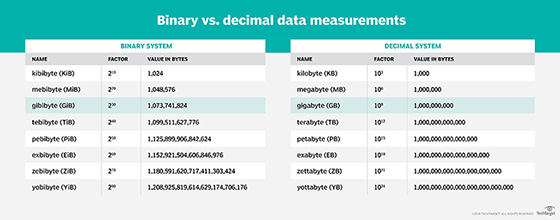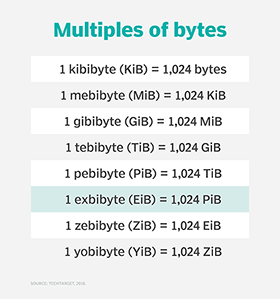gibibyte (GiB)
What is a gibibyte (GiB)?
A gibibyte (GiB) is a unit of measure of capacity in computing. The prefix gibi originated with the binary system for measuring data capacity, which is based on powers of two. One gibibyte equals 230 or 1,073,741,824 bytes.
The binary prefixes include kibi, mebi, gibi, tebi, pebi, exbi, zebi and yobi. The International Electrotechnical Commission (IEC) created these prefixes in 1998. Prior to that, the metric prefixes in the International System of Units (SI) were used across the board to refer to both the decimal system's power-of-10 multipliers and the binary system's power-of-two multipliers. The prefixes used in the SI system include kilo, mega, giga, tera, peta, exa, zetta and yotta.
Before 1998, context determined which system a person was referring to when they used the term gigabyte (GB). That term could refer to either 109 bytes (1,000,000,000 bytes) or 230 (1,073,741,824) bytes.
After 1998, who used which of the two systems depended on the discipline or industry. The communications, electronics and physics sectors are more likely to use the decimal system's metric units. The information technology and data storage industries tend to use the binary system and its non-metric units.
What gibibytes are used for
In the early days of computing, it wasn't a problem to use the same prefixes for both the power-of-10 multipliers and the power-of-two systems. Data storage capacity in those early days was at the low end of the multiplier scale. As a result, the difference in terms of the absolute value of the numbers generated by the two systems was relatively small.
For instance, a kilobyte of data is 1,000 bytes using the power-of-10 system; using the power-of-two definition, it's 1,024 bytes. That's only a 24-byte difference. However, as the scale of computing has grown and data storage capacity has expanded, the differences in terms of absolute numbers of bytes between the two measurement systems has been magnified. Using the two systems of measurement interchangeably has now created a problem.
As the computing industry has matured, having the same prefixes refer to two different units of measure became confusing. Drive manufacturers tended to use the decimal system when labeling the capacity of hard disk drives (HDDs) and solid-state drives. OS vendors often used the binary, power-of-two system to measure computer memory and data storage capacity. As a result, a disk drive manufacturer would label a new HDD as having 100 GB of capacity. However, when the customer installed that hard drive, the computer OS would report that the drive only had 93.13 GB capacity.
Discrepancies such as that led the IEC to create the new prefixes for the binary of measurement. If the OS had used the binary system prefixes in the example above, it would have reported 93.13 GiB instead of 93.13 GB.
While the IEC created the binary prefix system to solve the capacity measurement problem, in practice, the binary prefixes are mostly used in academic settings, technical literature and open system circles. They are not used much in commercial environments. As a result, confusion around these terms persists today.

How large is a gibibyte?
The binary data capacity measurements that are smaller than a gibibyte are:
- A byte -- a GiB is composed of 1,073,741,824 bytes.
- A kibibyte (KiB) -- a GiB is composed of 1,048,576 KiB.
- A mebibyte (MiB) -- a GiB is composed of 1,024 MiB.
Some binary data capacity measurements that are larger than a gibibyte include:
- A tebibyte, which is 1,024 times the size of a GiB.
- A pebibyte, which is 1,048,576 times the size of a GiB.
- An exbibyte, which is 1,073,741,824 times the size of a GiB.

What a GiB of data looks like
A single-layer DVD can hold approximately 4.38 GiB of data. An average laptop computer contains about 14.9 GiB of RAM. And 250 downloaded songs take up slightly less than 1 GiB of space.
Here are some other ways to visualize 1 GiB of data:
- 6,636 average emails sent and received.
- 268 10-megapixel photos.
- 379 one-minute YouTube videos.
Gibibyte vs. gigabyte
A gibibyte and a gigabyte are sometimes used as synonyms, though technically they do not describe the same amount of capacity. They are close in size, however. A gibibyte is equal to 230 or 1,073,741,824 bytes. A gigabyte is equal to 109 or 1,000,000,000 bytes. One gibibyte equals 1.074 gigabytes. That's a 7% difference.
In terms of a kibibyte vs. a kilobyte or a mebibyte vs. a megabyte, the difference between binary prefixes as units of measure and the decimal system is nearly negligible. But, when talking gibibytes vs. gigabytes, that 7% difference can start to add up.
Editor's note: This article was revised in 2023 by TechTarget editors to improve the reader experience.







